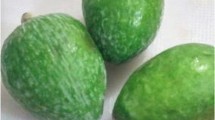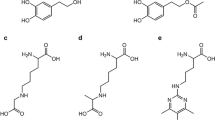Abstract
Advanced glycation end products (AGEs), which are the final products of glycation, have a major role in diabetic complication and neurodegenerative disorders. The 3-β-hydroxybutyrate (3BHB), a ketone body which is produced by the liver, can be detected in increased concentrations in individuals post fasting and prolonged exercises and in diabetic (type I) patients. In this study, the inhibitory effect of 3BHB on AGEs formation by glucose from the human serum albumin (HSA) was studied at physiological conditions after 35 days of incubation, using physical techniques such as circular dichroism and fluorescence spectroscopy, as well as differential scanning calorimetry (DSC). The fluorescence intensity measurements of glycated HSA by glucose (GHSA) in the presence of 3BHB indicate a decrease in AGEs formation. The DSC deconvolution profile results also confirm the protective role of 3BHB on incubated with glucose by preventing the enthalpy reduction of the HSA tail segment, compared with the deconvolution profile seen for incubated with glucose alone. The concentration of 3BHB used in this study is in accordance with the concentration detected in the body of individuals post fasting and prolonged exercises.







Similar content being viewed by others
Abbreviations
- AGEs:
-
Advanced glycation end products
- HSA:
-
Human serum albumin
- Glc:
-
Glucose
- GHSA:
-
Glycated human serum albumin
- 3BHB:
-
3-β-Hydroxybutyrate
- Lys:
-
Lysine
- DSC:
-
Differential scanning calorimetry
- CD:
-
Circular dichroism
References
Voziyan PA, Khalifah RG, Thibaudeau C, Yildiz A, Jacob J, Serianni AS, Hudson BG (2003) Modification of proteins in vitro by physiological levels of glucose. J Biol Chem 278:46616–46624. doi:10.1074/jbc.M307155200
Lapolla A, Traldib P, Fedelea D (2005) Importance of measuring products of non-enzymatic glycation of proteins. Clin Biochem 38:103–115. doi:10.1016/j.clinbiochem.2004.09.007
Brownlee M, Vlassara H, Cerami A (1984) Nonenzymatic glycation and the pathogenesis of diabetic complications. Ann Intern Med 101(1984):527–537
Friedlander MA, Witko-Sarsat V, Nguyen AT, Wu YC, Labrunte M, Verger C, Jungers P, Descamps-Latscha B (1996) The advanced glycation end product pentosidine and monocyte activation in uremia. Clin Nephrol 45:379–382
Khan MW, Rasheed Z, Khan WA, Ali R (2007) Biochemical, biophysical, and thermodynamic analysis of in vitro glycated human serum albumin. Biochemistry (Moscow) 72:146–152. doi:10.1134/S0006297907020034
Yim HS, Kang SO, Hah YC, Chock PB, Yim MB (1995) Free radicals generated during the glycation reaction of amino acids by methylglyoxal. J Biol Chem 270:28228–28233. doi:10.1074/jbc.270.47.28228
Frye EB, Degenhardt TP, Thorpe SR, Baynes JW (1998) Role of the Maillard reaction in aging of tissue proteins. J Biol Chem 273:18714–18719. doi:10.1074/jbc.273.30.18714
Stitt AW (2001) Advanced glycation: an important pathological event in diabetic and age related ocular disease. Br J Ophthalmol 85:746–753. doi:10.1136/bjo.85.6.746
Munch G, Shepherd CE, Mccann H, Brooks WS, Kwok JB, Arendt T, Hallupp M, Schofield PR, Martins RN, Hallidays GM (2002) Intraneuronal advanced glycation end products in presenilin-l Alzheimer`s disease. NeuroReport 13:601–604. doi:10.1097/00001756-200204160-00013
Baynes JW (2002) The Maillard hypothesis on aging: time to focus on DNA. Ann NY Acad Sci 959:360–367. doi:10.1111/j.1749-6632.2002.tb02107.x
Brownlee M, Vlassara H, Kooney A, Ulrich P, Cerami A (1986) Aminoguanidine prevents diabetes-induced arterial wall protein cross-linking. Science 232:1629–1632. doi:10.1126/science.3487117
Urios P, Grigorova-Borsos AM, Sternberg M (2007) Aspirin inhibits the formation of pentosidine, a cross-linking advanced glycation end product, in collagen. Diabetes Res Clin Pract 77:337–340
Booth AA, Khalifah RG, Hudson BG (1996) Thiamine pyrophosphate and pyridoxamine inhibit the formation of antigenic advanced glycation end-products: comparison with aminoguanidine. Biochem Biophys Res Commun 220:113–119. doi:10.1006/bbrc.1996.0366
Morimitsu Y, Yoshida K, Esaki S, Hirota A (1995) Protein glycation inhibitors from thyme (Thymus vulgaris). Biosci Biotechnol Biochem 59:2018–2021. doi:10.1271/bbb.59.2018
Guthrie JP, Jordan F (1972) Amine catalyzed decarboxylation of acetoacetic acid: the rate constant for decarboxylation of a β-imino acid. J Am Chem Soc 94:9136–9141. doi:10.1021/ja00781a025
Laffel L (1999) Ketone bodies: a review of physiology, pathophysiology and application of monitoring to diabetes. Diabetes Metab Res 15:412–426. doi:10.1002/(SICI)1520-7560(199911/12)15:6<412:AID-DMRR72>3.0.CO;2-8
Galan A, Hernandez J, Jimenez O (2001) Measurement of blood acetoacetate and β-hydroxybutyrate in an automatic analyser. J Autom Methods Manag 23:69–76. doi:10.1155/S1463924601000086
Fery F, Balasse EO (1985) Ketone body production and disposal in diabetic ketosis. A comparison with fasting ketosis. Diabetes 34:326–332
Cheng B, Yang X, Hou Z, Lin X, Meng H, Li Z, Liu S (2007) d-β-Hydroxybutyrate inhibits the apoptosis of PC12 cells induced by 6-OHDA in relation to up-regulating the ratio of Bcl-2/Bax mRNA. Auton Neurosci 134:38–44. doi:10.1016/j.autneu.2007.02.002
Taggart AK, Kero J, Gan X, Cai TQ, Cheng K, Ippolito M, Ren N, Kaplan R, Wu K, Wu TJ, Jin L, Liaw C, Chen R, Richman J, Connolly D, Offermanns S, Wright SD, Waters MG (2005) (d)-Beta-hydroxybutyrate inhibits adipocyte lipolysis via the nicotinic acid receptor PUMA-G. J Biol Chem 280:26649–26652. doi:10.1074/jbc.C500213200
Mejia-Toiber J, Montiel T, Massieu L (2006) d-Beta-hydroxybutyrate prevents glutamate-mediated lipoperoxidation and neuronal damage elicited during glycolysis inhibition in vivo. Neurochem Res 31:1399–1408. doi:10.1007/s11064-006-9189-5
Peters T Jr (1975) Serum albumin. In: Putnam FW (ed) The plasma proteins, 2nd edn. Academic Press, New York, pp 133–181
Dockal M, Carter DC, Ruker F (2000) Conformational transitions of the three recombinant domains of human serum albumin depending on pH. J Biol Chem 275:3042–3050. doi:10.1074/jbc.275.5.3042
Dugiaczyk A, Law SW, Dennison OE (1982) Nucleotide sequence and the encoded amino acids of human serum albumin mRNA. Proc Natl Acad Sci USA 79:71–75. doi:10.1073/pnas.79.1.71
Iberg N, Fliick R (1986) Nonenzymatic glycosylation of albumin in Vivo. Identification of multiple glycosylated sites. J Biol Chem 261:13542–13545
Sanchez-Ruiz JM, Lopez-Lacomba JL, Cortijo M, Mateo PL (1988) Differential scanning calorimetry of the irreversible thermal denaturation of thermolysin. Biochemistry (US) 27:1648–1652. doi:10.1021/bi00405a039
Bohlooli M, Moosavi-Movahedi A, Taghavi F, Habibi-Rezaei M, Seyedarabi A, Saboury A, Ahmad F (2013) Thermodynamics of a molten globule state of human serum albumin by 3-β-hydroxybutyrate as a ketone body. Int J Biol Macromol 54:258–263. doi:10.1016/j.ijbiomac.2012.12.018
Pico GA (1997) Thermodynamic features of the thermal unfolding of human serum albumin. Int J Biol Macromol 20:63–73. doi:10.1016/S0141-8130(96)01153-1
Sattarahmady N, Moosavi-Movahedi AA, Ahmad F, Hakimelahi GH, Habibi-Rezaei M, Saboury AA, Sheibani N (2007) Formation of the molten globule-like state during prolonged glycation of human serum albumin. Biochim Biophys Acta 1770:933–942. doi:10.1016/j.bbagen.2007.02.001
Fountoulakis M, Juranville JF, Manneberg M (1992) Comparison of the Coomassie brilliant blue, bicinchoninic acid and Lowry quantitation assays, using non-glycosylated and glycosylated proteins. J Biochem Biophys Methods 24:265–274
Habeeb AFSA (1966) Determination of free amino groups in proteins by trinitrobenzenesulfonic acid. Anal Biochem 14:328–336
Cayot P, Tainturier G (1997) The quantification of protein amino groups by the trinitrobenzenesulfonic acid: a reexamination. Anal Biochem 249:184–200
Le Maho Y, Van Kha HV, Koubi H, Dewasmes G, Girard J, Ferre P, Cagnard M (1981) Body composition, energy expenditure, and plasma metabolites in long-term fasting geese. Am J Physiol 241:E342–E354
Chesne S, Rondeau P, Armenta S, Bourdon E (2006) Effects of oxidative modifications induced by the glycation of bovine serum albumin on its structure and on cultured adipose cells. Biochimie 88:1467–1477
Kessel L, Kalinin S, Nagaraj RH, Larsen M, Johansson LB (2002) Time-resolved and steady-state fluorescence spectroscopic studies of the human lens with comparison to argpyrimidine, pentosidine and 3-OH-kynurenine. Photochem Photobiol 76:549–554. doi:10.1562/0031-8655(2002)0760549TRASSF2.0.CO2
Schmitt A, Schmitt J, Munch G, Gasic-Milencovic J (2005) Characterization of advanced glycation end products for biochemical studies: side chain modifications and fluorescence characteristics. Anal Biochem 338:201–215. doi:10.1016/j.ab.2004.12.003
Wang Y, Beck W, Deppisch R, Marshall SM, Hoenich NA, Thompson MG (2007) Advanced glycation end products elicit externalization of phosphatidylserine in a subpopulation of platelets via 5-HT2A/2C receptors. Am J Physiol Cell Physiol 293:C328–C336. doi:10.1152/ajpcell.0 0560.2006
Adisakwattana S, Sompong W, Meeprom A, Ngamukote S, Yibchok-anun S (2012) Cinnamic acid and its derivatives inhibit fructose-mediated protein glycation. Int J Mol Sci 13:1778–1789. doi:10.3390/ijms13021778
Ahmed N, Thornally PJ (2002) Chromatographic assay of glycation adducts in human serum albumin glycated in vitro by derivatization with 6-aminoquinolyl-N-hydroxysuccinimidyl-carbamate and intrinsic fluorescence. Biochem J 364:15–24
Rondeau P, Singh NR, Caillens H, Tallet F, Bourdon E (2008) Oxidative stresses induced by glycoxidized human or bovine serum albumin on human monocytes. Free Radic Biol Med 45:799–812. doi:10.1016/j.freeradbiomed.2008.06.004
Kojic-Prodic B, Molcanov K (2008) The nature of hydrogen bond: new insights into old theories. Acta Chim Slov 55:692–708
Charville H, Jackson DA, Hodges G, Whiting A, Wilson MR (2011) The uncatalyzed direct amide formation reaction: mechanism studies and the key role of carboxylic acid H-bonding. Eur J Org Chem 2011:5981–5990. doi:10.1002/ejoc.201100714
Thorpe SR, Baynes JW (2003) Maillard reaction products in tissue proteins: new products and new perspectives. Amino Acids 25:275–281
Bohlooli M, Moosavi-Movahedi AA, Taghavi F, Maghami P, Saboury AA, Moosavi-Movahedi Z, Farhadi M, Hong J, Sheibani N, Habibi-Rezaei M (2013) Investigation of thermal reversibility and stability of glycated human serum albumin. Int J Biol Macromol 62:358–364
Bouma B, Kroon-Batenburg LM, Wu YP, Brünjes B, Posthuma G, Kranenburg O, de Groot PG, Voest EE, Gebbink MF (2003) Glycation induces formation of amyloid cross-structure in albumin. J Biol Chem 278:41810–41819. doi:10.1074/jbc.M303925200
Michnik A (2003) Thermal stability of bovine serum albumin DSC study. J Therm Anal Calorim 71:509–519. doi:10.1023/A:1022851809481
Acknowledgments
The support of University of Tehran and Center of Excellence in Biothermodynamics (CEBiotherm), Iran National Science Foundation (INSF) and Iran National Elites Foundation (INEF) and UNESCO Chair on Indisciplinary Research in Diabetes is gratefully acknowledged.
Author information
Authors and Affiliations
Corresponding author
Rights and permissions
About this article
Cite this article
Bohlooli, M., Moosavi-Movahedi, A.A., Taghavi, F. et al. Inhibition of fluorescent advanced glycation end products (AGEs) of human serum albumin upon incubation with 3-β-hydroxybutyrate. Mol Biol Rep 41, 3705–3713 (2014). https://doi.org/10.1007/s11033-014-3235-1
Received:
Accepted:
Published:
Issue Date:
DOI: https://doi.org/10.1007/s11033-014-3235-1




